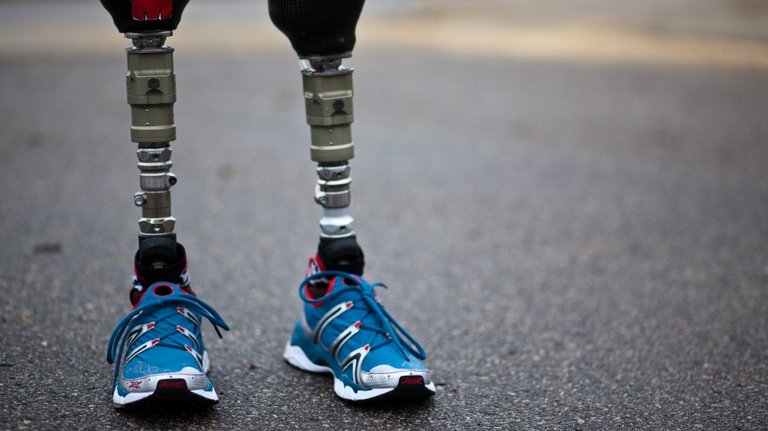The pattern of walking exhibited by an individual represents his solution to the problem of how to get from one point to another with minimum effort, adequate stability and acceptable appearance. The relative importance attached to each of these aspects differ from one individual to another, some being concerned mainly with attaining the destination while others are more concerned with their appearance in transit.

Photo credit: PBS
As stated previously the appearance of normal gait is the sum total of the various characteristic determinates of human locomotion. The gait of an amputee will depend upon the condition of the determinates he has remaining e.g. joints, skeletal links and muscles, the extent to which the prosthetic replacement mimic the original body parts and the interface between body and prosthesis.
BELOW KNEE AMPUTEE GAIT
The knee and hip are intact for most below knee amputees thus - provided there are no complications such as contractures - they can be expected to walk as well as non amputees of comparative health. The below knee prosthesis with the patellar tendon bearing design allows the amputee to flex his knee from heel-strike through to foot-flat and extend it from foot-flat to mid-stance. Swing phase is controlled by muscles which are intact but a little abnormality may be observed as hyper-flexion at the knee and hip to allow swing through.
source: Youtube
However, after good alignment of a well fitting prosthesis and correct gait (walking) training the below knee amputee can be regarded as having a minimum of disability. The success of the prosthesis depends upon an intimate fit of the socket to the stump (residual limb) and a prosthetic foot designed to minimize the loss of normal ankle function.
ABOVE KNEE AMPUTEE GAIT
The Stance phase
When the natural foot makes contact with the ground, the trunk is still descending. It is obviously necessary for the trunk to receive an upward acceleration if it is to maintain an average elevation. To accomplish this smoothly requires controlled plantar flexion of the ankle and flexion of the knee during the early portion of the stance phase.
In the succeeding portion of this phase, the controlled rotations of ankle and knee follow essentially the normal pattern until the heel begins to rise. At this time the body must not only prepare the natural leg for its forward swing but must also ensure that the trajectory of the body is such that it can be continued by the prosthetic leg which must soon take over support.
source: YouTube
The swing phase
The forward swing of the normal leg is initiated by powerful contraction of the plantar flexors of the ankle, followed by contraction of the hip flexors. The importance of the ankle muscles is emphasized by the analysis of energy during locomotion, where it can be seen that under normal circumstances the ankle extensors contribute about twice as much energy as do the hip flexors.
Lack of a mechanism which can produce a powerful ankle moment forces the amputee to rely heavily on hip musculature for initiating the forward swing. If an artificial leg had the same weight and moment of inertia as the normal, the amputee will require three times the normal exertion from his/her hip muscles, besides requiring them to become active sometimes earlier in the cycle.
Increased activity of the hip muscles of the prosthetic side affects not only the swinging of the prosthetic limb but movement of the rest of the body as well. Since those muscles are attached to the pelvis, their moment must be matched either by acceleration of the trunk or by contraction of the hip extensors on the natural side.
Physiological cost of amputee locomotion
The degree of disability and the difficulties of satisfactory replacement vary with the level of amputation. When the natural knee is preserved the problems of stability are much reduced. Conversely, disarticulation of the hip adds serious problems which necessitate use of pelvis and remaining musculature for replacement of function.
Thus it can be assumed that the below knee amputee expends only marginally more energy in ambulation (providing he has a well made prosthesis and no complications) than a normal patient of similar age and condition. An extensive literature search has failed to reveal any reports on the physiological cost of ambulation to the hip disarticulation patient, but some related to the above knee amputee.
CONCLUSION
An amputee's first concerns after amputation is the ability to move from one point to another with good cosmetics appearance and no pain. This involves careful selection of prosthetic components as per the level of amputation in consideration of weight and activity levels with basic understanding of the normal gait with above or below knee prosthesis.
I hope you enjoyed reading that one. I am a Prosthetist practicing in Nigeria, passionate about my work; and hoping to find a like-minded audience and community on Steem. In the meantime I would try to keep sharing my knowledge and experience in my chosen field, contributing to the vast information resource center that Steemit would become. I invite you to read my previous post on Upper-Limb Amputation, and watch this space to read my next post that would discuss the upper-limb prosthetic componentry parts and the alignment principles of the upper-limb prosthesis.
Regards,
Etieno Udeme
I know just a little about prosthetic components, but this was quite insightful. This is one medical milestone that I find really fascinating.